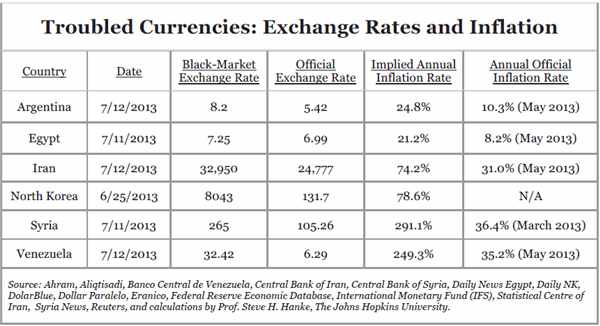Six countries with troubled currencies

The countries added to the Cato Institutes’ new Troubled Currencies Project have one thing in common, they are often in the news.
Iran, North Korea, Argentina, Venezuela, Egypt and Syria have all ignonimously been added to a basket of currencies “. . . in which users have lost confidence.”
Steven H. Hanke announced the Troubled Currencies Project that will use the latest black-market exchange-rate and implied-inflation-rate data to keep his reporting up-to-date.
Hanke said official stats from these governments are usually massaged and accurate data is then hard to come by.
Often, governments fabricate inflation statistics to hide their economic problems. In the extreme, countries simply stop reporting inflation data. Yes, official economic data from countries with troubled currencies often amount to nothing more than lying statistics and should be treated as such.
How can this problem be overcome? At the heart of the solution is the exchange rate. If free market exchange-rate data (usually black-market data) are available, a reliable estimate of an inflation rate can be determined. The principle of purchasing power parity (PPP), which links changes in exchange rates and changes in prices, allows for reliable inflation estimates during periods of elevated inflation. Indeed, PPP simply states that the exchange rate between two countries is equal to the ratio of their relative price levels. Accordingly, to calculate the inflation rate in countries with troubled currencies, a rather straightforward application of standard, time tested economic theory is all that is required.
Hanke catalogs the ills facing each of these currencies but notes that hyperinflation is still a ways off for all of these countries. Hyperinflation is defined as a monthly inflation rate of 50%. The highest inflation rate in Hanke’s chart is Syria’s annual rate of 291%.

Table from Cato Institute.
Image from Wikipedia, sweeping the pengő inflation banknotes
More News
Gates, Bezos-backed critical minerals explorer to ‘go big’ on Congo – report
April 27, 2025 | 08:27 am
{{ commodity.name }}
{{ post.title }}
{{ post.date }}



3 Comments
Ronnie Flynn
Yes I do think RSA is runners-up
ahe
FINLATAM offers Finance & Transactions Optimization in multicurrency & inflation environments. http://www.finlatam.com
Wally
MMMmmm: “Hanke said official stats from these governments are usually massaged and accurate data is then hard to come by”
Perhaps a solution would be for these beleagured coutries to adopt a programme to assist their economies, might I suggest “Qualitative Economics” then they could just send their currency priniting presses into overdrive? That would seem to sort things out.